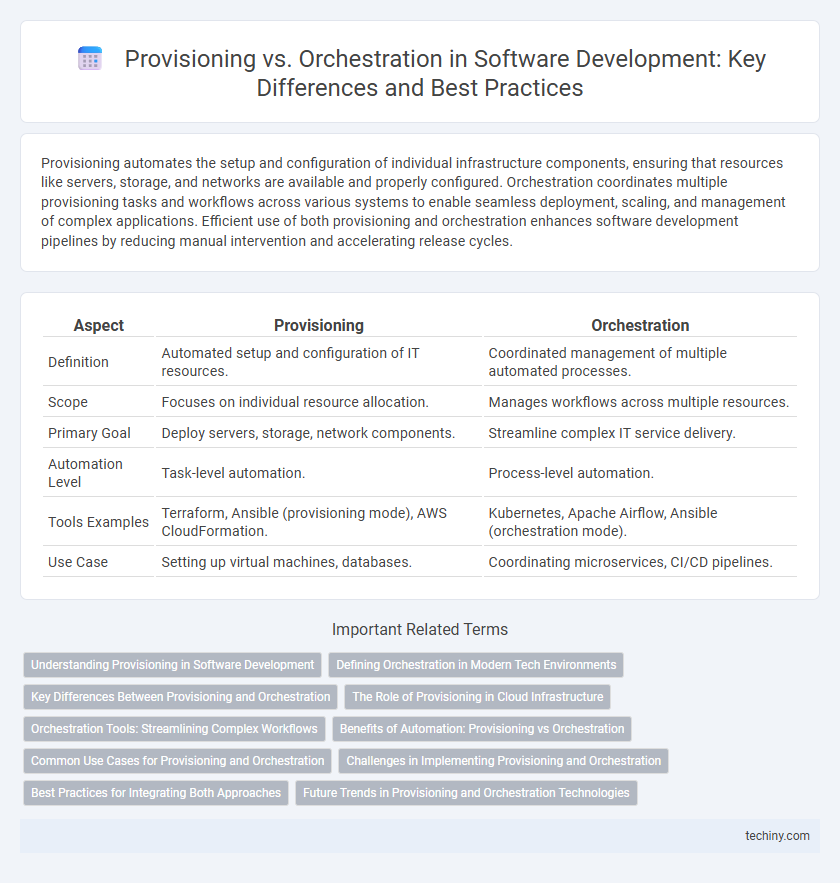Provisioning automates the setup and configuration of individual infrastructure components, ensuring that resources like servers, storage, and networks are available and properly configured. Orchestration coordinates multiple provisioning tasks and workflows across various systems to enable seamless deployment, scaling, and management of complex applications. Efficient use of both provisioning and orchestration enhances software development pipelines by reducing manual intervention and accelerating release cycles.
Table of Comparison
| Aspect | Provisioning | Orchestration |
|---|---|---|
| Definition | Automated setup and configuration of IT resources. | Coordinated management of multiple automated processes. |
| Scope | Focuses on individual resource allocation. | Manages workflows across multiple resources. |
| Primary Goal | Deploy servers, storage, network components. | Streamline complex IT service delivery. |
| Automation Level | Task-level automation. | Process-level automation. |
| Tools Examples | Terraform, Ansible (provisioning mode), AWS CloudFormation. | Kubernetes, Apache Airflow, Ansible (orchestration mode). |
| Use Case | Setting up virtual machines, databases. | Coordinating microservices, CI/CD pipelines. |
Understanding Provisioning in Software Development
Provisioning in software development refers to the automated process of setting up and configuring the necessary infrastructure, such as servers, storage, and network resources, to support application deployment and operation. It involves allocating and preparing hardware or virtual resources, ensuring that the environment meets specific technical requirements for software functionality. Effective provisioning reduces manual intervention, accelerates development cycles, and enhances scalability by enabling seamless resource management.
Defining Orchestration in Modern Tech Environments
Orchestration in modern tech environments involves automating the coordination, management, and integration of complex software systems and services to ensure seamless workflow execution. It goes beyond provisioning by linking disparate components such as containers, microservices, and cloud resources into a unified operational framework. Key tools like Kubernetes and Apache Airflow enable dynamic scaling, fault tolerance, and optimized resource utilization across distributed infrastructures.
Key Differences Between Provisioning and Orchestration
Provisioning involves the automated process of setting up and configuring individual infrastructure components such as servers, storage, or networks, ensuring resources are allocated and available for deployment. Orchestration coordinates and manages multiple automated tasks and workflows across various systems to streamline complex processes, integrating provisioning with configuration, deployment, and monitoring. Key differences lie in provisioning focusing on resource allocation and initial setup, while orchestration emphasizes workflow automation and managing interdependencies across the software development lifecycle.
The Role of Provisioning in Cloud Infrastructure
Provisioning in cloud infrastructure involves the automated allocation and configuration of resources such as virtual machines, storage, and networks, enabling developers to quickly deploy applications without manual setup. It ensures that the required environments are available and scalable by managing infrastructure components based on predefined templates and policies. This process is foundational for efficient cloud service delivery, directly impacting application performance and resource optimization in software development.
Orchestration Tools: Streamlining Complex Workflows
Orchestration tools automate and manage complex workflows by integrating multiple provisioning tasks into a cohesive system, enhancing efficiency and reducing manual errors. Popular platforms like Kubernetes, Apache Airflow, and Ansible coordinate container deployments, data pipelines, and configuration management across diverse environments. These tools ensure scalability and reliability by providing centralized control and real-time monitoring of multi-step processes in software development and IT operations.
Benefits of Automation: Provisioning vs Orchestration
Automation in provisioning accelerates the setup of infrastructure by enabling rapid deployment of servers, networks, and storage, reducing manual errors and operational costs. Orchestration builds on this by automating complex workflows and coordinating multiple automated tasks across diverse systems, ensuring seamless integration and enhanced scalability. This combination optimizes resource utilization, improves deployment consistency, and accelerates time-to-market for software applications.
Common Use Cases for Provisioning and Orchestration
Provisioning automates the setup and configuration of infrastructure components such as servers, storage, and network resources, commonly used in initial environment setups and resource scaling. Orchestration coordinates multiple automated tasks and services in a sequence to manage complex workflows, often applied in continuous integration/continuous deployment (CI/CD) pipelines and multi-cloud environment management. Both provisioning and orchestration streamline software development processes by reducing manual intervention and accelerating deployment cycles.
Challenges in Implementing Provisioning and Orchestration
Implementing provisioning and orchestration in software development faces challenges such as integrating diverse infrastructure components and managing complex dependencies across multiple environments. Ensuring scalability and maintaining consistent configuration while minimizing downtime requires robust automation tools and real-time monitoring. Security concerns and compliance management add further complexity, necessitating strict access controls and audit trails throughout the provisioning and orchestration processes.
Best Practices for Integrating Both Approaches
Implement automated provisioning frameworks such as Terraform or Ansible to ensure consistent infrastructure deployment while integrating orchestration tools like Kubernetes for dynamic workload management. Establish clear API-driven communication between provisioning and orchestration layers to enable seamless resource scaling and lifecycle automation. Regularly implement monitoring and feedback loops to optimize resource utilization and enhance system resilience across both provisioning and orchestration processes.
Future Trends in Provisioning and Orchestration Technologies
Future trends in provisioning and orchestration technologies emphasize automation driven by artificial intelligence and machine learning to enhance resource allocation efficiency and predictive scaling. Integration of edge computing and serverless architectures is accelerating the shift towards decentralized and on-demand provisioning models, optimizing latency and cost. Development of unified orchestration platforms supports multi-cloud and hybrid environments, ensuring seamless workload management and compliance across diverse infrastructures.
Provisioning vs Orchestration Infographic

 techiny.com
techiny.com